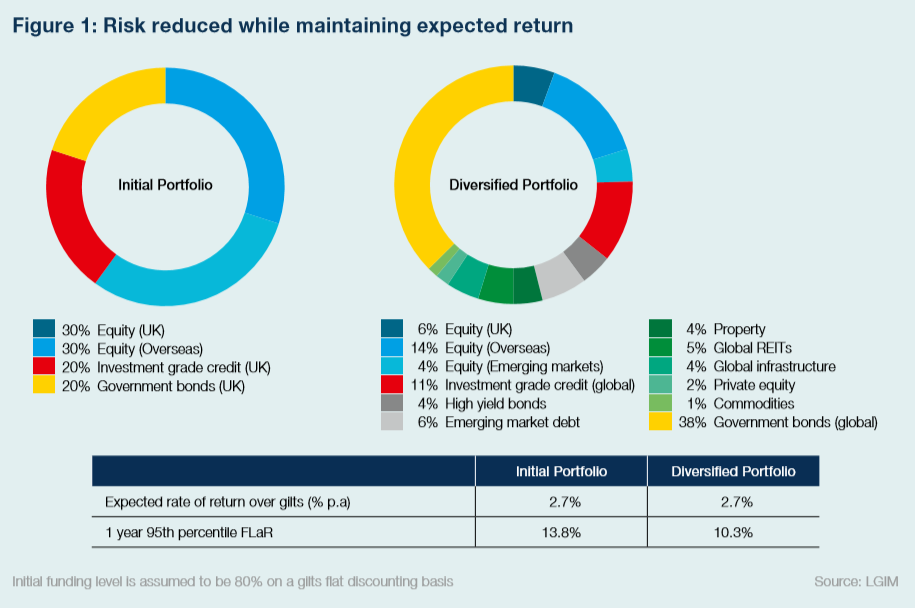Jonathan Joiner, senior solutions strategy manager, and Peter Boakes, solutions strategy manager, Legal & General Investment Management (LGIM)
2018 will probably be remembered as the year volatility returned to the market. As highlighted in our CIO’s investment outlook, there are a number of tail risks on the horizon that could cause this to continue. While there is no panacea for market volatility, these four simple steps can help reduce the impact.
Diversify by geography and asset class
In figure 1 we introduce an example pension scheme and show the effect of diversification on risk. The scheme’s current portfolio is a classic 60:40 split of equity and bonds which has an expected return of 2.7% over gilts but is exposed to significant downside risk, with a one-year funding level at risk (FLaR) of 13.8%.
This means that over a one-year period, in a 1-in-20 event, the funding level is expected to drop by 13.8%. In the right hand portfolio, we have diversified the asset allocation. The expected rate of return is unchanged but the risk (measured by FLaR) has been reduced by c.25%.
Diversification is not a new concept and UK pension schemes have certainly made improvements in this area. However, we believe there is still room for further improvement. For example, schemes with less that £10m of assets under management still have, on average, 40% of their equity exposure in UK equities.
This compares to just 15% for schemes that are over £1bn. This leaves smaller schemes in a higher risk position where they are more susceptible to UK-centric shocks.

Target an appropriate liability hedging level
Trustees face the challenge of balancing required exposure to growth assets with allocating to government bonds to reduce liability risk. This is where incorporating leverage, through swaps or synthetic bonds, can be a vital risk reduction tool.
Returning to the example scheme, the diversified portfolio only hedges 35% of the scheme’s liability risk owing to the low government bond allocation. However, the liability hedge ratio could be increased to 80% by using leverage. This would reduce the FLaR by a further 10%, whilst still maintaining a similar expected return.
Collateral and cash-flow management
The drawback of leverage is it requires the scheme to maintain sufficient collateral. This requirement for cash has been exacerbated by more and more pension schemes becoming cash-flow negative. It goes without saying that ensuring efficient collateral management is a key part of the solution.
Additionally, employing a cash-flow aware approach can help schemes mitigate this risk. Cash-flow negative schemes can be adversely affected during periods of heightened volatility where they need to liquidate assets to pay pensions. This can be at prices that may have strayed significantly from “fair value” and so losses are crystallised. Moving towards a cash-flow matched portfolio not only reduces this early sale risk but also reduces re-investment risk.
Currency exposure can mitigate risk
A bonus of diversifying assets globally is this leads to foreign currency exposure. Choosing a currency hedge ratio is not an exact science but we believe maintaining some exposure to foreign currency is an important risk mitigation tool. This is because of the exposure to safe-haven currencies such as the US dollar, Japanese yen and Swiss franc, which have historically been known for rallying when there are market downturns.


